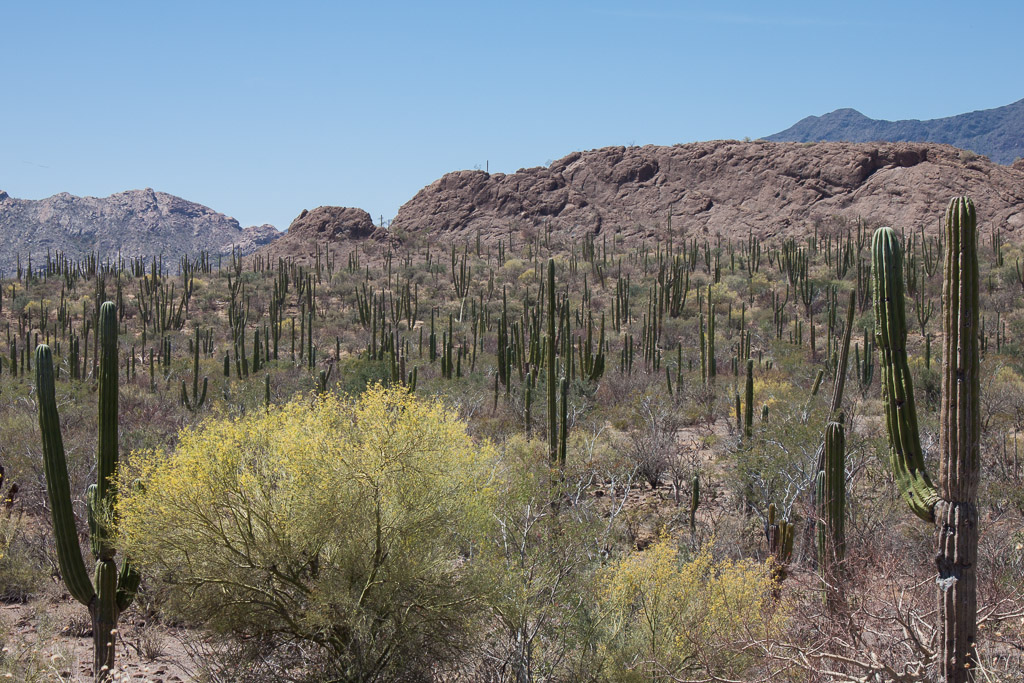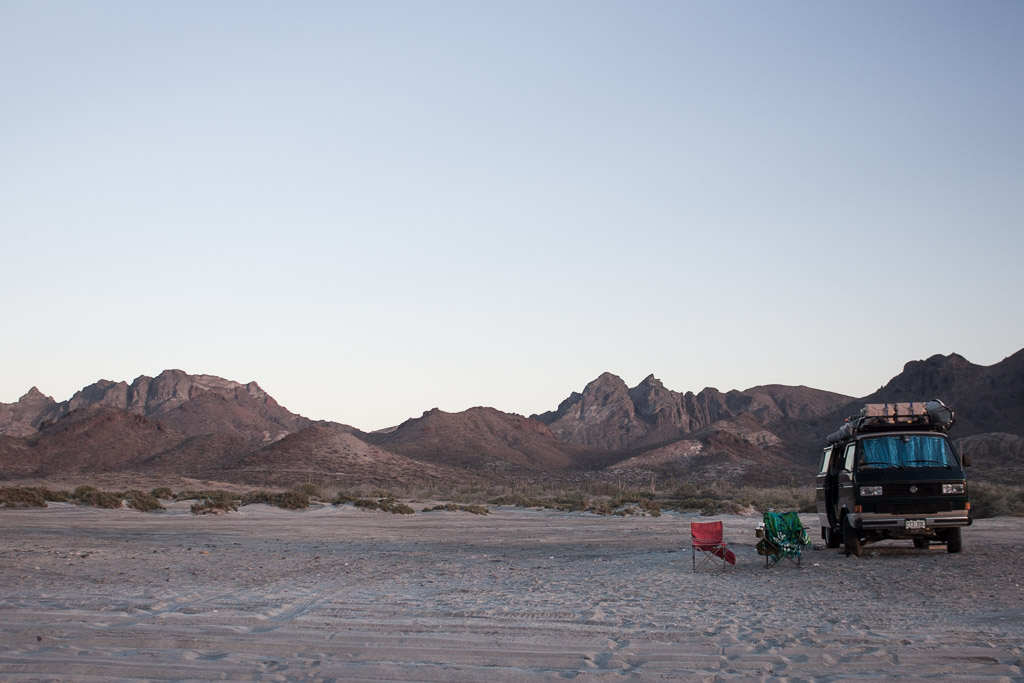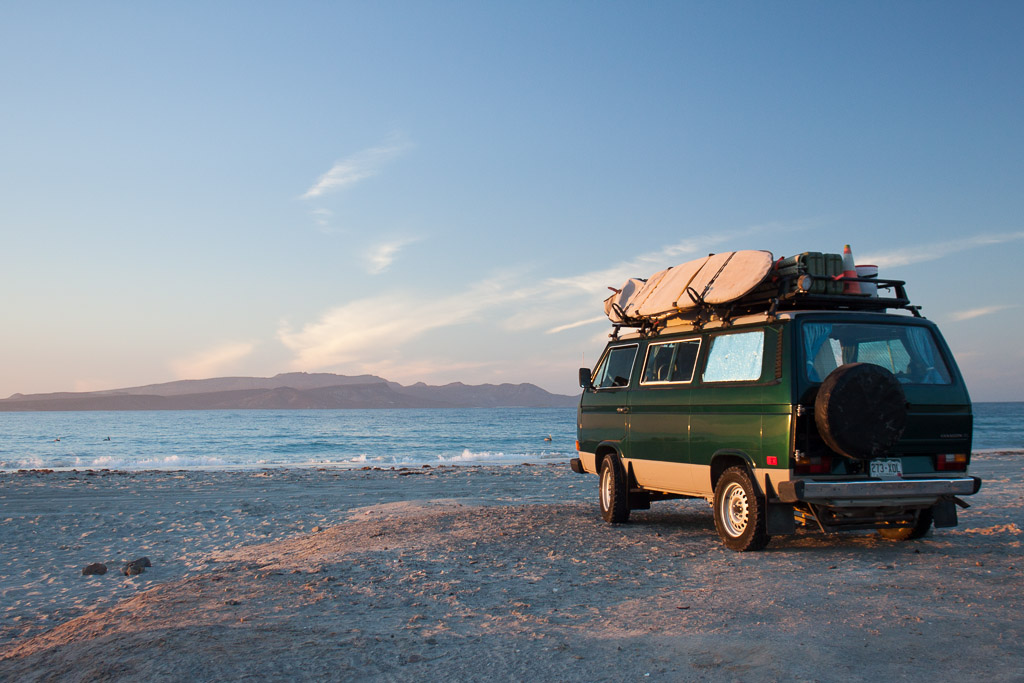In Baja California Sur we mostly stuck to paved and well-graded roads, on which we weaved back and forth between the Pacific coast and the Sea of Cortez, met some VW buddies, woke up to a red tide, and experienced the beginning of Semana Santa madness.
Upon leaving Guerrero Negro we drove out through one of the world’s largest salt flats to the Parque Natural de la Ballena Gris in Laguna Ojo de Liebre, the winter breeding grounds of the California gray whale. The salt flats were quite impressive. Operated by the Exportadora de Sal company, the flats cover an enormous area – one source said that they collect 24,000 tons of pure salt daily. Emily also oohed and aahed at the wide expanse of microbial mats, which are well known amongst microbiologists in the astrobiology community. We knew we were a bit late to see the whales, as their breeding time typically runs from December to March, so we didn’t pay to go out on a boat into the lagoon, but it was still cool to see where they breed and to support the park. The visitor center there is very eco-friendly, with composting toilets and recycling bins (which are hard to find elsewhere in Baja). We had seen several whales spouting not far from shore on our adventures in northern Baja, but weren’t sure at the time what type they were. Now we understand that they were likely California gray whales heading back north with their young.
We then left the Pacific and headed east across the desert. A nice couple that we had chatted with in Guerrero Negro recommended that we stop in San Ignacio, calling it a little oasis after driving through the hot, dry desert, and boy were they right. When we saw San Ignacio from the highway it looked like a mirage – date palms, a lagoon, and greenery galore! The town is small and quaint, with a very pleasant little central square covered by huge trees, where children were playing and old men were sitting around watching the occasional car go by.
We parked in the shade and checked out the well-restored 18th century mission. That’s where we met Geoff and Celine, an American-Italian couple from Florida, who were traveling down Baja in their awesome 1976 VW bus (“Alice”), which we had noticed parked across the street. They picked up two German hitchhikers, Jan and Michael, and the six of us camped out together in a amazing little paradise next to the lagoon called La Gitana (the gypsy). We were stoked to have some new friends and Chimera was thrilled to have a companion.
The next day we all headed east towards the Sea of Cortes. We stopped in Santa Rosalia to check out the French architecture (and bread), and to tour the little town of Mulege.
Then we headed south a bit further down the coast and found a great little beach right on the water, Playa Escondido (hidden beach), and set up camp. After a long, hot day of driving we were all ready to jump in the welcoming waters of The Sea of Cortez. The Sea of Cortez is much warmer and saltier than the Pacific, and almost dead calm – the only tiny wavelets we saw were from the soft breeze or the wake from a passing boat.
We were just about the deem our spot another slice of paradise when we noticed the increasing numbers of flies. By the time evening rolled around there were flies buzzing around all of our heads, so we donned all sorts of interesting head gear, burned a large clump of sage, and gathered whatever wood we could find to start a fire. Fortunately with nightfall and our raging campfire the flies disappeared and we enjoyed another lovely evening with our eclectic group of nomad friends, a delicious communal meal, and a bottle of tequila.
In the morning we all headed south along the gulf coast. We met up one last time in Loreto, where Goeff and Celine needed to let Alice cool down and readjust her valves, she had been running pretty rough. Jan and Michael were in a hurry to get to La Paz before the weekend, so we brought them as far as we planned to go for the day, then dropped them on the side of the highway, where they quickly hitched another ride South. After driving around looking at some unappealing beach camp spots, Emily spotted a secret little road that led off into the bushes and ended on a secluded beach with an impressive view of the nearby mountains.
The following morning we got an early start and drove west, across the desert, to the Pacific coast. We were in search of good waves.
We headed to Punta Conejo, a somewhat fickle point break that Tim had previously visited. On his last visit, the highlights had been the rats that deviously found a way into the camper in the middle of the night and a broken longboard after at end of a good surf session. This time, we heard no rats during the night, and woke up to windy, sloppy surf. Eventually, Tim decided to motivate and paddled out for a few waves. The poor surf conditions and expensive charge that the “caretaker” of the land was requiring did not inspire us to stay another night. We packed up and headed south on some back roads in hopes of finding a nice secluded beach.
We ended up at the next major point, Punta Marquez. Arriving at low tide we saw wonderful tide pools, a couple of Osprey fishing them, and a green arroyo to camp in, we pulled up to a fantastic spot with some firewood already piled up, nice bushes to provide shade, and a fantastic view of the point. We were thrilled to find such a great spot…and then we started seeing the bees. There were just a few at first, attracted by our garbage bag, then there were dozens. We threw the bag out of the van, hoping that was all they wanted, but it was no use, by that point the bees were everywhere. After fighting with them for a while over the garbage we surrendered and retreated, letting the bees keep their beautiful little camp spot all to themselves. We ended up not far away on a nice point with a million dollar view. Not a bad compromise.
We arrived at Punta Marquez in the late afternoon and the point break looked like it could be promising, so we awoke the next morning with hopes of a day of good surfing, only to discover that the ocean was bleeding. Red tide! While this biological phenomenon was a total bummer for our surfing expectations, it excited the microbiologist nerd in Emily, and even Tim agreed that it was strangely awesome. We spent a relaxing day reading, exploring the tide pools, making banana bread in the pressure cooker, and ogling at the red waves.
In the morning the red was even more intense, so we gave up on Baja surf and headed to La Paz, where we found a beautiful, very clean, and mostly empty RV park right on the bay. Aquamarina RV Park is owned by Lizzy, an adorable 81-year old Mexican woman, whose large, attractive house is right in the middle of the small park. She has excellent English and loved to talk, so we learned all about how she and her husband had been married for 55 years and ran a dive company out of La Paz for over 40 years. Sadly, he died two years ago and now Lizzy runs the RV park with her son-in-law Roger, a very nice man who took good care of us.
We took an afternoon to give Chimera some well-deserved love, which was an interesting and entertaining experience all around and deserves it’s own blog post (coming up next!). The following day we went to the ferry terminal to get our Mexico vehicle import permit (which is required on the mainland) and check into the ferry schedule and costs, then headed to the beach to look for a camp spot.
We had been warned about the madness of Semana Santa, the week before Easter, which many Mexicans have off of work or school and head to the beach to camp and party. We were told that huge families would be flocking to the beaches, covering them with tents and tarps and awnings, tying them to the side of our van, and blasting music into the night. This we clearly wanted to avoid. But we went to the beach anyway. We read about a beautiful beach north of La Paz where the camping was free and usually empty…except for Semana Santa. We went there anyway. Playa Tecolote was indeed beautiful, and when we arrived, only half of it was covered with tents and tarps and parties, so we headed to the other half, where the sand was too deep for most two-wheel drive vehicles. We noticed the awesome, giant yellow Unimog that we had seen two times before heading down the Baja coast and parked nearby so we could ogle at it for a while.

The giant yellow Unimog. This photo was actually taken further north near Playa Escondida, the second time we saw this amazing vehicle (the first was in San Ignacio, the third at Playa Tecolote).
We swam in the warm gulf waters, soaked in the afternoon sun, and enjoyed some tequila cocktails while we people-watched in amusement. As the evening wore on more and more campers filled in around us, music blared, and ATVs roared by, but it never got near the level of madness that we expected. But then again it was only Tuesday night.
At several points throughout the evening we watched as people brazenly attempted to drive across the deeper sand and got stuck. Most of them only had to put their trucks or SUVs in four-wheel-drive to get out, but there were also some two-wheel-drive vehicles who weren’t so lucky. Two different vehicles got stuck in deep sand right next to us. Happily, we pulled our sand ladders off the roof and helped them attempt to dig out, and when that didn’t work we attached the snatch strap and easily pulled them out. Chimera beamed with pride and grinned at the giant yellow Unimog next door.
The following morning we took off before we had to rescue any more vehicles from the sand. That afternoon we said our goodbyes to Baja and boarded the cargo ferry, headed for mainland Mexico.

































It’s great to see you guys in the beginning of your trip. We miss Baja! I am sure I will be reading this blog long after we are done with own trip and back in California.
One thing though–Tim, is that you under that van, checking CV joints while the van is supported only by the very unstable Bilstein jack? Please don’t do that! Always have a jack stand if you go under the car with a wheel off, and also, just in case, always put the wheel you took off under the axle.
I apologize for the way this sounds. But really, I myself have had the van come off that same jack suddenly (I wasn’t anywhere near the bottom of the car though). Those things are not stable, and should only be used to change a tire, never to raise the van in order to work under it. You can always check CVs with the wheels on, in any case.
Please take care, and greetings from Patagonia!
Thanks Juan, I will definitely heed your advice. I really know better, but guess that I wasn’t thinking that day. Thanks for looking out.
~Tim
I am really enjoying your posts Em and Tim! Way to live! Safe travels and good thoughts coming your way.
Ame
I love Baja !!!!!!
I can’t believe we hadn’t checked out your blog until now, it’s awesome! We are sitting in block island, looking at a cool van across the street and thought about you guys. Such a fun time and great memories. We will dig into the rest of your adventures soon but it looks like you are well on your way! So amazing, we wish you all the very best in your travels, enjoy the road and can’t wait to hear more.
Geoff and Celine (and Alice)
Hola amigos! We were just talking about you two, wondering where you are and what adventures you’ve been having. So great to have shared some Baja time with you. See you down the road some time!